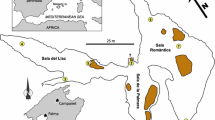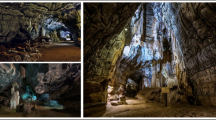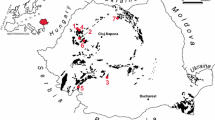Abstract
A six month survey of radon, radon progeny and condensation nuclei (CN) has been conducted in an Australian tourist cave. The measurements have been made continuously at two sites within the cave: one a small chamber with a high air exchange rate close to one entrance and connected to several other entrances by complex passages; the other a large chamber with a low air exchange rate 1 km from the nearest entrance. The measurements form a basis for evaluation of the accuracy with which dose due to radon can be determined for different monitoring strategies. It is shown that the estimate of dose based on the measurement of radon concentration and recommendations in ICPR-65, is low by a factor of 1.3 at the well ventilated site and 1.5 at the site with a low air exchange rate and low CN. At each site the weekly average equilibrium factor and unattached fraction were steady, leading to the possibility of establishing a cave system average of these factors. However, given the technical diffuculties involved, it may not be practicable to make enough unattached fraction measurements to fully represent the cave system. Therefore it may be necessary to use a conservative approach to the dosimetry and add 50% to values determined by the ICRP-65 conversion convention.
Similar content being viewed by others
References
J. Hakl, I. Hunyadi, A. Varhegyi, in: Radon measurements by etched track detectors,R. Iric andS. A. Darrawi (Eds), World Scientific Press, Singapore, 1996.
G. J. Butterweck, J. Porstendorfer, A. Reineking, J. Keston, Radiat. Prot. Dosim., 45 (1992) 167.
Y. S. Cheng, T. R. Chen, P. T. Wasiolek, A. Vanengen, Aerosol Sci. Technol., 26 (1997) 74.
S. B. Solomon R. Langroo, J. R. Peggie, R. G. Lyons, J. M. James, Australian Radiation Laboratory, Australia, Tech. Report ARL/TR 119, 1996.
International Commission on Radiological Protection Publication 65, Protection against Radon-222 at Home and at Work, Annals, of the ICPR 23, 1994.
S. B. Solomon, Radiat. Prot. Dosim., in press.
S. B. Solomon, M. B. Cooper, R. S. Obrien, L. Wilkenson, Radiat. Prot. Dosim., 45 (1992) 171.
L. W. Pollak, A. L. Metnieks, School of Cosmic Physics, Dublin Institute for Advanced Studies, Dublin, Ireland, Tech. Note 9, 1960.
J. L. Gras, J. Aerosol Sci., 15 (1984) 523.
Author information
Authors and Affiliations
Rights and permissions
About this article
Cite this article
Zahorowski, W., Whittlestone, S. & James, J.M. Continuous measurements of radon and radon progeny as a basis for management of radon as a hazard in a tourist cave. J Radioanal Nucl Chem 236, 219–225 (1998). https://doi.org/10.1007/BF02386346
Received:
Issue Date:
DOI: https://doi.org/10.1007/BF02386346




